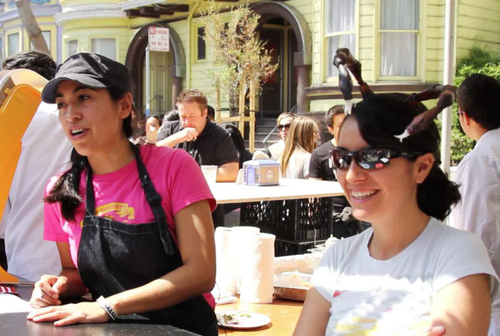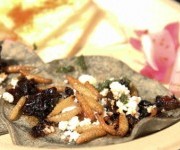 On a sunny afternoon, the crowd of customers around the Don Bugito stand debates the merits of various gateway bugs.
On a sunny afternoon, the crowd of customers around the Don Bugito stand debates the merits of various gateway bugs.
“Crickets,” says a towheaded youngster, who would look like a character in a Mark Twain novel, were it not for the fact that he is digging into a cup of ice cream sprinkled with toasted mealworms. “Those are the first bugs I ate. I bought them at a candy store in Napa.”
“A scorpion is a good beginner bug,” says one woman, biting into a taco. She ate one at a night market in China. “They look pretty badass — but they’re so dry that there’s no guts. It tasted like a potato chip.”
Behind them, Monica Martinez, RISD graduate and bug pusher, rings up “PreHispanic tacos,” bugs on ice cream, and lemonade (no bugs). She’s a fan of the wax moth larvae herself. “They’re pure fat,” says Martinez, and make a good starter bug. “But they’re the fat that you want to eat. Not Burger King fat.” They’re also cute, she says. “Mealworms still look a little evil to me.”
Among the small but devoted band of ecologists and entomologists who promote eating insects (the technical term is entomophagist), Don Bugito is notable for its low-key populism. Some entomophagists will pose in front of a fish-eye lens with a wriggling scorpion held over their mouth in order to get attention. Others, like retired entomology professor Gene DeFoliart, will write beautifully detailed papers on how foreign aid projects that encourage bug-eating cultures to stop foraging and start raising chickens, pigs, and cattle may deprive them nutritionally.
 Monica Martinez, proprietor of Don Bugito, left.It is a widely held belief among the entomophagists of the world that, eventually, we’re all going to eat bugs. It may take a while; even a casual student of the dietary habits of modern humans is likely to conclude that most of them are likely to wait until they’ve eaten most of the fish and mammals in the world first. But some see bugs as livestock waiting to be discovered — like an understudy at a Broadway musical. Crickets are twice as efficient at using feed as chickens and pigs and nearly six times as efficient as cattle. Edible insects also produce much less in the way of greenhouse gases than cattle.
Monica Martinez, proprietor of Don Bugito, left.It is a widely held belief among the entomophagists of the world that, eventually, we’re all going to eat bugs. It may take a while; even a casual student of the dietary habits of modern humans is likely to conclude that most of them are likely to wait until they’ve eaten most of the fish and mammals in the world first. But some see bugs as livestock waiting to be discovered — like an understudy at a Broadway musical. Crickets are twice as efficient at using feed as chickens and pigs and nearly six times as efficient as cattle. Edible insects also produce much less in the way of greenhouse gases than cattle.
Martinez was pulled into the world of bug munching by social connections — while living with the artist Philip Ross, the two became preoccupied with the idea of urban agriculture, and began raising mealworms in their apartment. Martinez designed a series of sleek white Bauhaus-inspired apartment complexes for the insects — one half for beetles, which lay the eggs that turn into mealworms, and one half for the mealworms themselves.
After several redesigns (it turned out that the beetles had specific ventilation needs in order to work up the initiative to reproduce), she had working prototypes. Those prototypes turned into a gallery show, and Martinez decided it would be a neat idea to drum up publicity for the show by asking the restaurant around the corner to throw a bug dinner in conjunction with the opening.
 Wax moth larvae tacos.The dinner was so wildly successful that it nearly eclipsed the show itself. And it taught Martinez a lesson. If you’re interested in broadening people’s perspective of food, handing them something delicious-looking on a plate is more persuasive than providing them with a box filled with wiggling larvae — no matter how pretty the box happens to be.
Wax moth larvae tacos.The dinner was so wildly successful that it nearly eclipsed the show itself. And it taught Martinez a lesson. If you’re interested in broadening people’s perspective of food, handing them something delicious-looking on a plate is more persuasive than providing them with a box filled with wiggling larvae — no matter how pretty the box happens to be.
Suddenly, she was drafting a business plan for the small business incubator La Cocina, and filling out applications for food handling permits. What had started as social practice art began shaping up into a strange hybrid. In Mexico, where people skim lake fly eggs off the surface of Lake Textoco and lay them out to dry (they taste just like shrimp, says Martinez), where the state of Taxco has an entire festival devoted to eating Jumiles, a small stink bug, and where the larvae of ants of the genus Liometopum are harvested and served as a delicacy, Martinez’s work did not go unnoticed. She was invited to join Numina Femina, a group exhibition focusing on Latino women in the arts. It asked her to, among other things, set up a larvae taco stand in front of the Mexican consulate in San Francisco.
She refers to her business as a “PreHispanic Snackeria.” “There was no lactose before the Spaniards came,” she says, “and so we used to eat insects. They provided all the things milk would have provided, plus fiber.”
In the meantime, the mealworm apartment complex remains in Martinez’s apartment, somewhat neglected. The charm of eating them has worn off. When asked which bugs taste better than mealworms, Martinez sighs and answers, “All of them.”
“I take care of them,” she says. “I feed them. Even though I’m getting sick of them.”
It’s an interesting transition: from art project, to livestock, to pet. At what point do you cut loose from an early concept that becomes progressively less delicious? “It’s like when you raise any living organism,” says Martinez, with a shrug. “I’m attached to them.”



